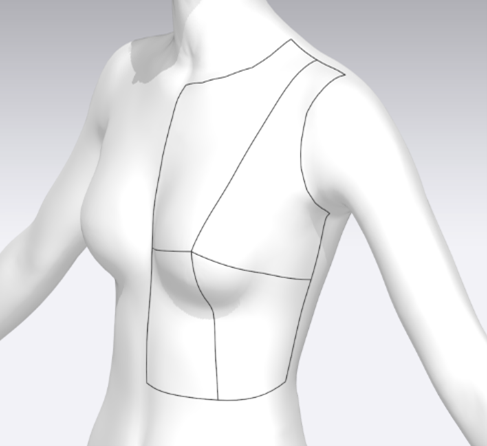AI-assisted Pattern Generator for Garment Design
DOI:
https://doi.org/10.25367/cdatp.2024.5.p195-206Keywords:
ai-assisted pattern construction, pattern generation, CAD flattening, machine learningAbstract
This paper introduces an AI-assisted pattern generator, aimed to simplify garment design by flattening the pattern creation in an automated process from 3D scans for users without knowledge of conventional pattern construction. This garment tool plug-in computerizes the development of scanned persons into 3D shell surface meshes, which are automatically unwrapped into 2D patterns, streamlining the traditionally complex aspects of garment design for novices. The process uses advanced AI algorithms to facilitate the conversion of 3D scans into usable patterns. Machine learning adapts to different garment styles (close-fitting, regular fit and loose-fitting), ensuring a broad applicability, while customization options allow a precise adaption to individual body measurements. This AI-assisted tool enables a wider audience to generate customized garment creation.
References
Speicher-Utsch, S. Kosten sparen mit 3D-Design. TextilWirtschaft 2017. Available online: https://www.textilwirtschaft.de/business/news/Technologie-3D-Produktentwicklungnimmt-Fahrt-auf-205495
Moltenbrey, F.; Tilebein, M. Potenziale und Herausforderungen neuer digitaler Interaktionssysteme im Kollektionsentwicklungsprozess der Bekleidungsindustrie. Mensch-Technik-Interaktion in der digitalisierten Arbeitswelt, Schriftenreihe der Wissenschaftlichen Gesellschaft für Arbeits- und Betriebsorganisation (WGAB) e. V., Freitag, M. (Ed.), GITO mbH Verlag Berlin 2020, pp. 59-78.
Hofenbitzer, G. Grundschnitte und Modellentwicklungen. Verlag Europa-Lehrmittel, Haan-Gruiten 2018.
Huang, H.Q.; Mok, P. Y.; Kwok, Y. L.; Au, J. S. Block pattern generation: From parameterizing human bodies to fit feature-aligned and flattenable 3D garments. Computers in Industry 2012, 63(7), 680-691.
Choi, Y. L.; Nam, Y.; Choi, K. M.; Cui, M. H. A method for garment pattern generation by flattening 3D body scan data. In Digital Human Modeling: First International Conference on Digital Human Modeling, ICDHM 2007, Held as Part of HCI International 2007, Beijing, China, July 22-27, 2007. Proceedings 1, pp. 803-812. Springer Berlin Heidelberg, 2007.
Mosinki, E.; Pohl, H. Grundlagen der Bekleidungskonstruktion: System Optikon. Institut für Textil- und Bekleidungswesen 1992.
Kosel, G.; Rose, K. Development and Usage of 3D‐Modeled Body Shapes for 3D‐Pattern Making. Proc. of 3DBODY.TECH 2020 - 11th Int. Conf. and Exh. on 3D Body Scanning and Processing Technologies, Online/Virtual, 17-18 Nov. 2020, #14. DOI: https://doi.org/10.15221/20.14.
Burgo, F. Il figurino di moda. Studio delle proporzioni, tecniche di colorazione. Donna, uomo, bambino/a, accessori. Ediz. italiana e inglese, ISBN 8890010169 Instituto di Moda Burgo; Bilingual Edition, 2005.
Narain, R.; Samii, A.; O’Brien, J. F. Adaptive Anisotropic Remeshing for Cloth Simulation. ACM Transactions on Graphics 2012, 31(6), 152.
Wang, H. M.; Ramamoorthi, R.; O’Brien, J. F. Data-Driven Elastic Models for Cloth: Modeling and Measurement. ACM Transactions on Graphics 2011, 30(4), 71.
Liu, L. J.; Xu, X. Y.; Lin, Z. J.; Liang, J. B.; Yan, S. C. Towards Garment Sewing Pattern Reconstruction from a Single Image. ACM Transactions on Graphics 2023, 42, 200.
Korosteleva, M.; Lee, S.-H. Dataset of 3D Garments with Sewing Patterns (1.0). Zenodo 2021. DOI: https://doi.org/10.5281/zenodo.5267549.
Korosteleva, M., Lee, S. H. NeuralTailor: Reconstructing sewing pattern structures from 3D point clouds of garments. ACM Transactions on Graphics 2022, 41(4), 158.
Donner, E. Handbuch für die Bekleidungsindustrie und den Bekleidungs-Einzelhandel: Ein Lehr- und Nachschlagewerk für die gesamte Herren- und Knabenbekleidung. Springer 2013.
Ebner Media Group GmbH & Co. KG. https://www.muellerundsohn.com/ (accessed 2024-30-03)
Hohenstein Laboratories GmbH & Co. KG. https://www.hohenstein.de/de/kompetenz/passform/schnitt-service (accessed 2024-30-03)
Zhang, F. F. Designing in 3D and Flattening to 2D Patterns. PhD thesis, North Carolina State University, 2015.
Optitex, 2024. 3D PRODUCT CREATION SUITE. https://optitex.com/solutions/odev/3d-production-suite/ (accessed 2024-30-03)
Assyst GmbH. https://www.assyst.de/de/produkte/cad/index.html (accessed 2024-30-03)
LECTRA. https://www.lectra.com/en (accessed 2024-30-03)
Browzwear Solutions Pte Ltd. https://browzwear.com/ (accessed 2024-30-03)
CLO Virtual Fashion. https://www.clo3d.com/en/ (accessed 2024-30-03)
Blender https://www.blender.org/ (accessed 2024-30-03)
Abdel Kader, E. A. S.; Mohamed, R. H.; Ali, R. The Role of Artificial Intelligence (AI) Applications in fashion design and Forecasting in the garment industry, An Analytical study. International Design Journal 2022, 12, 203-214.

Downloads
Published
How to Cite
Issue
Section
License
Copyright (c) 2024 Michael Danner, Elena Brake, Gabriela Kosel, Yordan Kyosev, Katharina Rose, Matthias Rätsch, Holger Cebulla

This work is licensed under a Creative Commons Attribution 4.0 International License.





